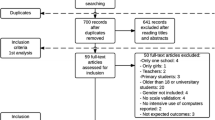Abstract
Access to the Internet is an important issue in terms of equity and the UK government has stated ‘Our goal is to ensure that everyone who wants it has access to the Internet by 2005.’ (UK Online Annual Report, 2002). This survey of Internet use by 1340 secondary school students from four schools in the Teesside area of England was carried out in order to assess whether the government is realising its ambition of Internet access amongst 11–16 year-olds, and also to determine whether or not gender differences exist in Internet use. Furthermore, the data supplied are intended to inform later studies of more specific aspects of children's Internet use. Generally, it was found that most children used the Internet, were quite comfortable with it, and used it for a variety of applications. However, a considerable minority of respondents also considered themselves non-users of the Internet. There were also some gender differences found in the data which in general suggested something of a male bias towards Internet use. It was concluded that these are issues that need to be addressed for the purposes of equity and if the government is to achieve its goal of Internet access for all by 2005. A number of suggestions for further research into Internet use by children are also suggested in this paper.
Similar content being viewed by others
References
Allen, B.J. (1995) Gender and computer-mediated communication. Sex Roles, 32(7/8), 557–563.
Boneva, B., Kraut, R., & Frohlich, D. (2001) Using email for personal relationships: the difference gender makes. American Behavioral Scientist, 45(3), 530–549.
economy_measurement/downloads/NEMW(08)_JB_e-society.pdf
Chen, M. (1986) Gender and computers: the beneficial effects of experience on attitudes. Journal of Educational Computing Research, 2(3), 265–281
Cone, C. (2001) Technically speaking: girls and computers. In P. O' Reilly, E.M. Penn, & K. de Marrais (Eds.), Educating young adolescent girls. Mahwah, Jersey: Lawrence Erlbaum Associates; pp. 171–187.
Department for Education and Skills. (2000). Public examinations GCSE/GNVQ and GCE/AGNVQ in England 2000. On-line. Available http://www.dfes.gov.uk/statistics/DB/VOL/v0279/170-t31.htm
Durndell, A. & Haag, Z. (2002). Computer self efficacy, computer anxiety, attitudes towards the Internet and reported experience with the Internet, by gender, in an east European sample. Computers in Human Behaviour, 18, 521–535.
Greenfield, D. (1999). Psychological characteristics of compulsive Internet use: a preliminary analysis. Cyberpsychology and Behaviour, 2(5), 403–412.
Heichler, E. (1997). Internet lacks content for women. On-line. Available http:www.computerworld.com/printthis/1997/0,4814,4759,00.html
Herring, S., Johnson, D.A., & DiBenedetto, T. (1995). “This discussion is going too far!” Male resistance to female participation on the Internet. In K. Hall & M. Bucholtz (Eds.), Gender articulated: language and the socially constructed self. New York: Routledge; pp. 67–96.
Jackson, L.A., Ervin, K.S., Gardner, P.D., & Schmitt, N. (2001). Gender and the Internet: women communicating and men searching. Sex Roles, 44(5/6), 363–379.
Jordan, T. (2001). Measuring the Internet: host counts versus business plans. Information, Communication and Society, 4(1), 34–53.
Katz, J.E. and Aspden, P. (1997) Barriers to and Motivations for Using the Internet: Results of a National Opinion Survey In G.L. Rosston and Waterman, D. (Eds.), Selected Papers from the 24th Annual Telecommunications Policy Research Conference (TPRC). Hillsdale, New Jersey: Lawrence Erlbaum Associates, pp. 79–94.
LaFerle, C., Edwards, S., & Lee, W. (2000) Teens' use of traditional media and the Internet. Journal of Advertising Research, 4(3), 55–64.
Lenhart. (2000). Who's not online: 57% of those without Internet access say they do not plan to log on. Pew Internet and American Life Project. On-line. Available http:www.pewinternet.org/reports/pdfs/Pew_Those_Not_Online_Report.pdf
Nachmias, R., Mioduser, D., & Shelma, A. (2000). Internet usage by students in an Israeli high school. Journal of Educational Computing Research, 22(1), 55–73.
Odell, P.M., Korgen, K.O., Schumacher, P., & Delucchi, M. (2000). Internet use among female and male college students. Cyberpsychology and Behaviour, 3(5), 855–862.
Office for National Statistics. (2002a). Figures concerning adult Internet use. On-line. Available http://www.statistics.gov.uk/CCI/SearchRes.asp?term=Internet
Office for National Statistics. (2002b). Neighbourhood statistics. On-line. Available http://www.neighbourhood.statistics.gov.uk/home.asp
Office for National Statistics. (2002c). Populations size: 7.9% from a minority ethnic group. On-line. Available http://www.statistics.gov.uk/cci/nugget.asp?id=273
Pew Internet and American Life Project. (2000a, May 10). Tracking online life: how women use the Internet to cultivate relationships with family and friends [Online]. Available http://www.pewinternet.org/reports/
Schumacher, P. & Morahan-Martin, J. (2001). Gender, Internet and computer attitudes and experiences. Computers in Human Behaviour, 17, 95–110.
Sherman, R.C., End, C., Kraan, E., Cole, A., Campbell, J., Birchmeier, Z., & Klausner, J. (2000). The Internet gender gap among college students: forgotten but not gone? Cyberpsychology and Behaviour, 3(5), 885–894.
Teo, T.S.H. & Lim, V.K.G. (2000). Gender differences in Internet usage and task preferences. Behaviour and Information Technology, 19(4), 283–295.
Turkle, S. (1988). Computational reticence: why women fear the intimate machine. In C. Kramarae (Ed.), Technology and women's voices. New York and London: Routledge; pp. 41–61.
UK Online Annual Report. (2002). On-line. Available http://www.e-envoy.gov.uk/oee/oee.nsf/ sections/esummit-ukoannrep-word/$file/UKO%20Annual%20Report%202002.doc
Weiser, E.B. (2000). Gender differences in Internet use patterns and internet application preferences: a two-sample comparison. Cyberpsychology and Behaviour, 3(2), 3167–177.
Author information
Authors and Affiliations
Corresponding author
Rights and permissions
About this article
Cite this article
Madell, D., Muncer, S. Gender Differences in the Use of the Internet by English Secondary School Children. Social Psychology of Education 7, 229–251 (2004). https://doi.org/10.1023/B:SPOE.0000018552.85903.4d
Issue Date:
DOI: https://doi.org/10.1023/B:SPOE.0000018552.85903.4d




